After an implementation of Dynamics GP for one of our clients, I have received a critical and weird case stating that all the inventory related transactions (Shipment, Inventory Adjustment and Sales) are recorded with a “Zero” unit cost, although, they are entering the correct unit cost when receiving the shipment. Here is the starting point of the case”
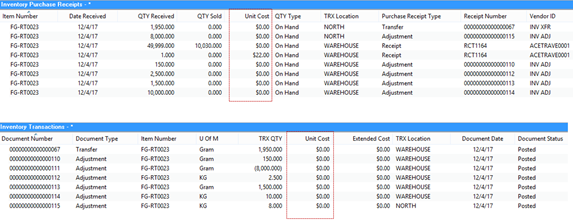 >> All unit cost fields are zero, on both In and Out transactions
>> All unit cost fields are zero, on both In and Out transactions
Troubleshooting:
The item number is defined as a sales inventory, FIFP perpetual valuation method and assigned to a KG unit of measurement. Currency decimals on the system level and distribution modules is set to (3) for this selected currency used for this item. The following is the UOM setup of KG:
Here is the interesting part, starting with the first transaction on this item (which is a shipment), the following are the transaction details:
- Quantity shipped: 50
- UOM: KG
- Unit Cost (for the KG): 0.44
Now, on the inventory module, the system will break down the unit cost into the smallest unit of measurement, and record the cost layer in the base unit of measurement (IV10200). In case of rounding, the system will consider splitting the cost layers into two cost layers >> Reference: unit cost and currency decimal setup
- Quantity in Base UOM: 50 * (1000) = 50,000 Gram
- Unit cost (for the Gram): 0.44/1000 = 0.00044
The result that the Inventory Module will split into two cost layers, (49,999 Gram) and (1 Gram), the one gram will have the variance which is the total cost in our scenario (22). Here is the purchase receipt smart list again:
By now, it is clear that any (out) transaction withdrawing from this cost layer will have a zero unit cost, which is incorrect. Until, all 49,999 Gram are consumed, the unit cost will be zero. Then when withdrawing the final one gram, the total cost of the whole 50 KG will be consumed.
Correction Criteria
- Post or delete all pending “saved” transactions
- Change the currency decimals (on the distribution level, not the system level) to encompass more than the current number of decimals for this specific item, not necessarily all the items.
- Adjust cost for the historical transactions
In order to change currency decimals, go to Microsoft Dynamics GP > Tools > Utilities > Inventory > Change Decimal Places
Helping Note !
- Before running the change decimal places utilities, no user in the company should be working on any of the inventory related transactions (Such as:Inventory Adjustment, Transfer, Receiving, Sales …etc).
- No transaction should be saved or pending on a purchase order, receiving …etc.
- One pressing on “Process”, you will be warned that Manufacturing isn’t updated when you change currency decimals. It’s fine, just proceed
In order to adjust the cost, go to Microsoft Dynamics GP > Tools > Utilities > Inventory > Adjust Cost
After processing the cost adjustment, a report will show all the journal entries created to adjust the cost on the “General Ledger” as well. Please be noted that not only the current cost layer; which is being adjusted, will be affected. ALL related “out” transaction which withdraws from this specific cost layer will be affected accordingly.
The affected transactions will be listed in the Purchase Receipt Update Detail report, after processing the cost adjustment.
Here is the journal entries created on the General Ledger, it will affect inventory and inventory offset accounts (COGS)
Best Regards,
Mahmoud M. AlSaadi
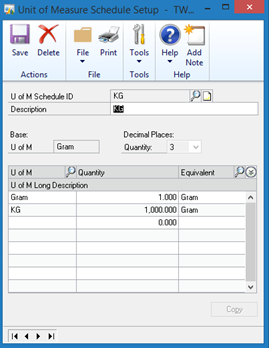


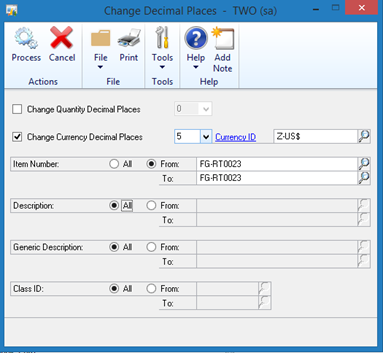
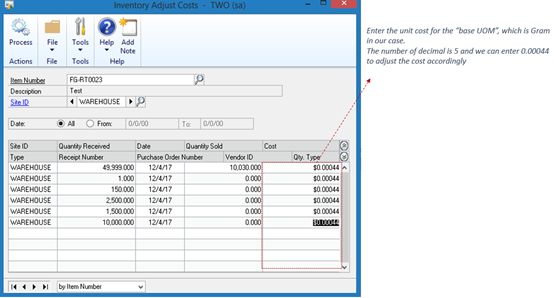
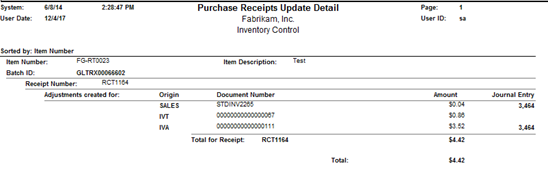

No comments:
Post a Comment